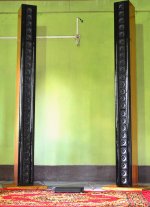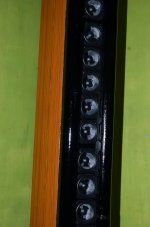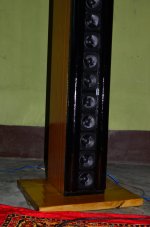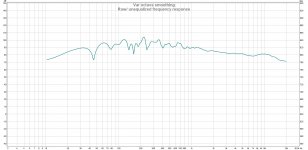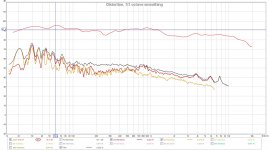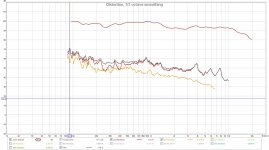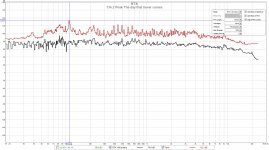I finally managed to find the feet of my amplifier and the rest of the equipment so I took them off the wall were it was hanging beside the line array. It did clean up the right side response but it's still a little rougher than the left side. It seems the damping on the left side-wall really helps there. I have received warning though that I may not place more damping panels in the room. So for now this seems the best I can do to get both sides as similar as possible:
An externally hosted image should be here but it was not working when we last tested it.
Red is right, blue is left... 1/12 octave smoothing...

That is one heck of a response curve.
Well, it's an interesting result either way. I haven't been able to replicate that problem myself, but then i don't have a line array system with so many drivers. Imo it's some kind of reflection or resonance in the system - the RCL parameters of the cable are probably exacerbating the problem.No magic, just tiny differences... lets see if this clears things up.
Group Delay in REW of the different wires, you guess which is which...
http://www.rsr-concepts.com/diyma/gdold.jpg
http://www.rsr-concepts.com/diyma/gdnew.jpg
Both smoothed 1/6 oct and gated 5 ms. Note the scale on the left!
I told you it was timing differences, didn't I. Too bad I didn't think looking at this before.
Here's the worst as you normally view it:
http://www.rsr-concepts.com/diyma/differentscale.jpg
Keep in mind that you're looking at the highest frequencies of 25 3.5" full range drivers.
I tried to find time each day to listen to this last measurement/DRC combo.
Usually it's pretty easy to get impressed with new settings but as days pass by the thrill wears off. I'm happy to say this advancement hasn't disappointed yet. I keep being sucked into the music, that's what we do it for right?
Sticking to the goals seems to pay off. Slowly but surely I find ways to improve, with all the set barriers I can't break. With that I mean I am restricted by the room and my spouse to for instance add further damping/diffusion. But working on the parts I can control seems to work out very well. Over the last couple of months I've been experimenting with all kinds of things. Not every idea worked but never the less I made an improvement.
Here's the above measurement compared to one dating back in January:

Easy to see I managed to get way better balance between the left and right channel. Part of that will be processing, but also my change in the baffle construction and dare I say it, different speaker wire.
Little things done that keep improving the signal. If this is it, I would be more than happy enough already. But... maybe there's even more to be had! So until I run out of ideas to try I'm going to keep fiddling to see if I can further improve my system. Harder to do than building new type of speakers and see what that brings... but I'd say, in the end, more rewarding.
If anything, I believe in this concept of line arrays. That choice seems to pay off pretty good! Although it was a compromise mainly to save space in placement as well as floor space in general I figured there were many plusses to this concept as well. I'm kind of glad I went this route despite all warnings about comb filtering, center to center spacing etc.
The better my results are, the more I'm convinced timing is everything in audio reproduction. I see lots of people that are convinced no speaker can do every type of music well. I still don't get that. Not in my opinion. I think it has more to do with the room/speaker combination. The further I get with this, the more everything seems to sound better.
Bass extension is important though. For a while I had a pretty steep roll off below 35 Hz. The music still was ok, but I lost a big part of the thrill. As you see above I still have some roll off, but more gentle like I had in the beginning. It brings so much more atmosphere, ambience compared to leaving it out by rolling off steeper.
I bet it would be even better if I added more low frequency, but I hesitate doing that with the arrays. I want to keep them save.
So what am I saying here? I'd say, pick your best idea for a speaker and stick to it! Really stick to it! Don't start building something else till you are sure you have milked out the concept as far as it goes. It is a slow process and not all changes are going to be an improvement but slowly but surely you WILL get better sound. I had done this in my car and it took a long time but it was very rewarding. I started out like most, wanting to change woofers and tweeters on a monthly basis. But when I got reasonable sound, I stuck to it and improved all the little things. The rattles in the car doors, blocking outside noise, perfecting the crossovers etc (active crossovers, helped out by a partly passive circuit due to restrictions in DSP abillities). But also decoupling of the sub from the car, better baffles behind the woofers and 3D printed face plates for the tweeters.
Like now, not everything worked but over a period of 3 years(!) I succeeded to get a substantial improvement that led to this project. My car sounded way better than my home stereo at that point.
Now things are back as they should be. My home stereo wins by miles. But there are still tiny little things that work better in my car. So I'm not done yet!
Usually it's pretty easy to get impressed with new settings but as days pass by the thrill wears off. I'm happy to say this advancement hasn't disappointed yet. I keep being sucked into the music, that's what we do it for right?
Sticking to the goals seems to pay off. Slowly but surely I find ways to improve, with all the set barriers I can't break. With that I mean I am restricted by the room and my spouse to for instance add further damping/diffusion. But working on the parts I can control seems to work out very well. Over the last couple of months I've been experimenting with all kinds of things. Not every idea worked but never the less I made an improvement.
Here's the above measurement compared to one dating back in January:

Easy to see I managed to get way better balance between the left and right channel. Part of that will be processing, but also my change in the baffle construction and dare I say it, different speaker wire.
Little things done that keep improving the signal. If this is it, I would be more than happy enough already. But... maybe there's even more to be had! So until I run out of ideas to try I'm going to keep fiddling to see if I can further improve my system. Harder to do than building new type of speakers and see what that brings... but I'd say, in the end, more rewarding.
If anything, I believe in this concept of line arrays. That choice seems to pay off pretty good! Although it was a compromise mainly to save space in placement as well as floor space in general I figured there were many plusses to this concept as well. I'm kind of glad I went this route despite all warnings about comb filtering, center to center spacing etc.
The better my results are, the more I'm convinced timing is everything in audio reproduction. I see lots of people that are convinced no speaker can do every type of music well. I still don't get that. Not in my opinion. I think it has more to do with the room/speaker combination. The further I get with this, the more everything seems to sound better.
Bass extension is important though. For a while I had a pretty steep roll off below 35 Hz. The music still was ok, but I lost a big part of the thrill. As you see above I still have some roll off, but more gentle like I had in the beginning. It brings so much more atmosphere, ambience compared to leaving it out by rolling off steeper.
I bet it would be even better if I added more low frequency, but I hesitate doing that with the arrays. I want to keep them save.
So what am I saying here? I'd say, pick your best idea for a speaker and stick to it! Really stick to it! Don't start building something else till you are sure you have milked out the concept as far as it goes. It is a slow process and not all changes are going to be an improvement but slowly but surely you WILL get better sound. I had done this in my car and it took a long time but it was very rewarding. I started out like most, wanting to change woofers and tweeters on a monthly basis. But when I got reasonable sound, I stuck to it and improved all the little things. The rattles in the car doors, blocking outside noise, perfecting the crossovers etc (active crossovers, helped out by a partly passive circuit due to restrictions in DSP abillities). But also decoupling of the sub from the car, better baffles behind the woofers and 3D printed face plates for the tweeters.
Like now, not everything worked but over a period of 3 years(!) I succeeded to get a substantial improvement that led to this project. My car sounded way better than my home stereo at that point.
Now things are back as they should be. My home stereo wins by miles. But there are still tiny little things that work better in my car. So I'm not done yet!
Last edited:
Choices in processing...
The above frequency response can be had with minimum phase filtering or a bit of linear phase thrown into the mix. The differences between the 2 is phase behavior in the upper part of the frequency spectrum. Here are 2 impulses/step responses showing the difference:

All minimum phase filtering, notice the somewhat soft start of the impulse.
No pre-ringing.

Same settings as above but with PSFilterType set to "L"
The soft start is filled in but with some pre-ringing evident.
I listened to both versions for some time and can't make up my mind. Ideally I'd like to stick to minimum phase and get the best results that way. I'll try this again with the impedance correction in place to see if that has some effect on this part of the frequency spectrum.
The above frequency response can be had with minimum phase filtering or a bit of linear phase thrown into the mix. The differences between the 2 is phase behavior in the upper part of the frequency spectrum. Here are 2 impulses/step responses showing the difference:

All minimum phase filtering, notice the somewhat soft start of the impulse.
No pre-ringing.

Same settings as above but with PSFilterType set to "L"
The soft start is filled in but with some pre-ringing evident.
I listened to both versions for some time and can't make up my mind. Ideally I'd like to stick to minimum phase and get the best results that way. I'll try this again with the impedance correction in place to see if that has some effect on this part of the frequency spectrum.
That's really nice result. I am very very impressed with a listening position measurement of frequency response and SR that looks like that. It's like watching a fairy tale for audio that happened in real life. This thing must sound so good - I commend you for sticking to one speaker over 2 years instead of two dozen like me 
I had to do the try everything first to learn my way and experience what works best for me. I still don't have a checkbox for "Line Array" or "DRC" yet. Those two together seem to be ideal for magic sound.
I still really like my synergy style horns. Having a front loaded bass horn is also really cool for low distortion bass.
My latest stint with a 3-way OB actively controlled and transient perfect also sounds quite good. Different than horns though - just the opposite as sound is reflected everywhere with OB.
I had to do the try everything first to learn my way and experience what works best for me. I still don't have a checkbox for "Line Array" or "DRC" yet. Those two together seem to be ideal for magic sound.
I still really like my synergy style horns. Having a front loaded bass horn is also really cool for low distortion bass.
My latest stint with a 3-way OB actively controlled and transient perfect also sounds quite good. Different than horns though - just the opposite as sound is reflected everywhere with OB.
After trying to help out on the http://www.diyaudio.com/forums/full-range/275730-convolution-based-alternative-electrical-loudspeaker-correction-networks-10.html#post4390020 thread I experimented with the Excess phase window length. I remember browsing trough Audiolense and it had separate windows for frequency and time correction. It's a bit different from DRC but not all that different.
The DRC documentation has a rule of thumb to set EPLowerWindow to about 1/16 length of the MPLowerWindow (minimum phase window used to correct the frequency response).
In Audiolense I had seen defaults that were a bit longer than that. So why not try I thought. Using the option in DRC to predict the output I tried a couple of Excess phase window lengths. After a while I decided to set it to half of what the Minimum phase window would be.
Low and behold it fixed my phase wraps at 130 Hz an 70 Hz for my left channel!

But as seen above, phase wasn't that beautiful and it created a few mild dips in the frequency response. I figured since I was using a template with all minimum phase settings that might be the reason for some of those anomalies.
After setting a few important variables to linear phase I got a much smoother response:

(EPPFFlatType = L, PLType = L, PSFilterType = L and a flat target)
I had tried using RePhase combined with DRC to get results as good as this and had failed. No matter what I did I couldn't successfully implement two convolvers in my audio chain and keep it sounding good/natural. With the above change in the Excess Phase window I was getting exactly what I was after!
The impulse/STEP was looking promising as well:

Time for some listening I'd say! I first listened to the flat target, fun but overly bright... So after a couple of minutes I reverted back to my old target, the downwards slope from ~ 30 Hz to 20 kHz. Much better... or is it... I listened to music for quite a while and while it did sound good, I still felt it was off a bit. I left the stereo running in the background at lower levels, just to let that sink in a bit. Even changed it back to the flat target after quite a while. To me it felt like the balance was off. Not sure what to say. I figured I might need new measurements to confirm if that would agree with the plots...
Today, after thinking it trough a bit I came up with a different point of view. The same imbalance had stuck me before with EQ windowing (basically the Minimum Phase window settings). What if I were to shorten the Excess Phase window length? Keep true to the thought of only cleaning up direct sound and leaving the later arrivals alone?
Again some plots were made and examined till I found my goal. By setting the EPLowerWindow to 1/3 of MPLowerWindow, keeping EPUpperWindow and MPUpperWindow the same and playing with the EPWindowExponent variable I was able to solve the early drop in Frequency at ~130 Hz, but not cure the obvious room effect at 70 Hz. For the right channel it meant I still have some traces of reflections in the measurement that were always there.
But viewing the first 20 to 30 ms with REW's Psychoacoustic smoothing showed smooth frequency response and phase for that "window". After that first period the reflections etc... are allowed and not eliminated like with the longer Excess phase windowing.
I have to say, first impression? Very good! Now I have to find out how it will be in the longer run. But my "space" is back, feels like hearing a live performance again. That was what I was missing yesterday. Time will tell though, if I have/allow myself enough of that before I do my next experiment .
.
Here's the new IR/STEP from the shorter EP windows:

One thing immediately jumps out by comparing it to the above IR/STEP.
It's a bit more restless, more of the evident reflections remain. But way more pleasing after a longer listening session. More real space, depth and live feel.
Something to think about!
P.S. when looking at these steps and the ones in my earlier post, notice the difference in time scale. The early ones were about -1 to 9 ms and these are -1 to 20 ms!
The DRC documentation has a rule of thumb to set EPLowerWindow to about 1/16 length of the MPLowerWindow (minimum phase window used to correct the frequency response).
In Audiolense I had seen defaults that were a bit longer than that. So why not try I thought. Using the option in DRC to predict the output I tried a couple of Excess phase window lengths. After a while I decided to set it to half of what the Minimum phase window would be.
Low and behold it fixed my phase wraps at 130 Hz an 70 Hz for my left channel!

But as seen above, phase wasn't that beautiful and it created a few mild dips in the frequency response. I figured since I was using a template with all minimum phase settings that might be the reason for some of those anomalies.
After setting a few important variables to linear phase I got a much smoother response:

(EPPFFlatType = L, PLType = L, PSFilterType = L and a flat target)
I had tried using RePhase combined with DRC to get results as good as this and had failed. No matter what I did I couldn't successfully implement two convolvers in my audio chain and keep it sounding good/natural. With the above change in the Excess Phase window I was getting exactly what I was after!
The impulse/STEP was looking promising as well:

Time for some listening I'd say! I first listened to the flat target, fun but overly bright... So after a couple of minutes I reverted back to my old target, the downwards slope from ~ 30 Hz to 20 kHz. Much better... or is it... I listened to music for quite a while and while it did sound good, I still felt it was off a bit. I left the stereo running in the background at lower levels, just to let that sink in a bit. Even changed it back to the flat target after quite a while. To me it felt like the balance was off. Not sure what to say. I figured I might need new measurements to confirm if that would agree with the plots...
Today, after thinking it trough a bit I came up with a different point of view. The same imbalance had stuck me before with EQ windowing (basically the Minimum Phase window settings). What if I were to shorten the Excess Phase window length? Keep true to the thought of only cleaning up direct sound and leaving the later arrivals alone?
Again some plots were made and examined till I found my goal. By setting the EPLowerWindow to 1/3 of MPLowerWindow, keeping EPUpperWindow and MPUpperWindow the same and playing with the EPWindowExponent variable I was able to solve the early drop in Frequency at ~130 Hz, but not cure the obvious room effect at 70 Hz. For the right channel it meant I still have some traces of reflections in the measurement that were always there.
But viewing the first 20 to 30 ms with REW's Psychoacoustic smoothing showed smooth frequency response and phase for that "window". After that first period the reflections etc... are allowed and not eliminated like with the longer Excess phase windowing.
I have to say, first impression? Very good! Now I have to find out how it will be in the longer run. But my "space" is back, feels like hearing a live performance again. That was what I was missing yesterday. Time will tell though, if I have/allow myself enough of that before I do my next experiment
Here's the new IR/STEP from the shorter EP windows:

One thing immediately jumps out by comparing it to the above IR/STEP.
It's a bit more restless, more of the evident reflections remain. But way more pleasing after a longer listening session. More real space, depth and live feel.
Something to think about!
P.S. when looking at these steps and the ones in my earlier post, notice the difference in time scale. The early ones were about -1 to 9 ms and these are -1 to 20 ms!
Last edited:
Let's not be shy here; you've got a linear phase system going. I can predict what your step response looks like left of t=0; please show -20ms to 20ms view. A pre-ringing exists of low amplitude in the impulse response; totally inaudible 99% of listening material and I believe it is good to show this in building general case for DRC, rePhase, and Kirkeby generated correction filters that work wonderfully when details are paid attention to.
Yes, great goings on here. Keep it coming.
Yes, great goings on here. Keep it coming.
Yes indeed, I finally managed to come close enough to my goal: the linear phase system!
With quite a bit of SPL capacity to boot! Here's the plot of -20ms to 20 ms:

None of the pre-ringing control in DRC was used here. I haven't noticed any so far.
I'll continue to work on this to try and clean up the signal. The peak at 6 ms, is the wall behind the listening position (much to close, but I have to live with it). However I might get it down more by a little more toe-in of the speakers (only a degree or two). I did test damping material besides my big poster and it helped to get that peak down. But I can't do much about it, not going to hang an even bigger poster .
.
My planned ceiling swap (removing the metal ceiling) should have an effect too, but it has to wait a while longer. Life does have a habit of getting in the way of the things we want.
With quite a bit of SPL capacity to boot! Here's the plot of -20ms to 20 ms:

None of the pre-ringing control in DRC was used here. I haven't noticed any so far.
I'll continue to work on this to try and clean up the signal. The peak at 6 ms, is the wall behind the listening position (much to close, but I have to live with it). However I might get it down more by a little more toe-in of the speakers (only a degree or two). I did test damping material besides my big poster and it helped to get that peak down. But I can't do much about it, not going to hang an even bigger poster
My planned ceiling swap (removing the metal ceiling) should have an effect too, but it has to wait a while longer. Life does have a habit of getting in the way of the things we want.
Looking nice; the negative step before t=0 does its thing. No pre-ringing control is needed with well crafted frequency dependent windowing. Seeing the waveform of it here requires zooming in amplitude to a fairly microscopic level.
Thanks for putting this up. I'm looking forward to using some of your tips and tricks.
Here is -20ms to 20ms IR and SR predicted for correction filter allowing my TC9FD FAST top to make reasonable square waves starting at about 150Hz and looking good >3.5kHz:
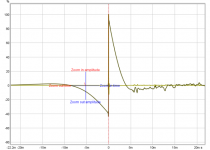
Zoom in of amplitude reveals negligible pre-ringing; zero audibility when tested with music track. Intended use is in IMD crossover study, for which a posting will happen soon:
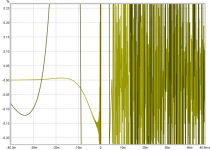
Indeed, microscopic zoom in is required to see the pre-ringing.
Thanks for putting this up. I'm looking forward to using some of your tips and tricks.
Here is -20ms to 20ms IR and SR predicted for correction filter allowing my TC9FD FAST top to make reasonable square waves starting at about 150Hz and looking good >3.5kHz:

Zoom in of amplitude reveals negligible pre-ringing; zero audibility when tested with music track. Intended use is in IMD crossover study, for which a posting will happen soon:

Indeed, microscopic zoom in is required to see the pre-ringing.
Just tried the new REW beta 6. This is the one with the Frequency Dependant Windowing build in. It does make all graphs I use the windowing on overly smooth. I guess i'll hold on to the Beta 3 as well. Seems to show a little more detail although I have no clue about the exact windowing used. Still thrilled to see REW evolve this way though! very useful indeed!
While I had my last graph on I thought about looking at my speakers -3 dB point etc.
-3 dB at 17 Hz to 17700 Hz! Not 20 to 20000 but close enough... subject to change of coarse. But I definitely like having that low rumble there. Much more pleasing than without it. I could get more treble by getting the speakers on axis but I like the imaging better this way at ~15 deg off axis.
Parts are on their way for the next experiment, I decided to wait with my measurement session till they arrive. Meanwhile enjoying the music they make. Not unimportant .
.
While I had my last graph on I thought about looking at my speakers -3 dB point etc.
-3 dB at 17 Hz to 17700 Hz! Not 20 to 20000 but close enough... subject to change of coarse. But I definitely like having that low rumble there. Much more pleasing than without it. I could get more treble by getting the speakers on axis but I like the imaging better this way at ~15 deg off axis.
Parts are on their way for the next experiment, I decided to wait with my measurement session till they arrive. Meanwhile enjoying the music they make. Not unimportant
Finally my own version 
Inspired by line array concept, I've just completed my own version.
25x per channel of 3.5 inch black kevlar coned Tymphany TPY03.
This is my initial test setup & measurements. I am using a car amplifier
All the measurements are taken at 3 metres distance form the speakers, 15 deg off-axis.
Included in the attachments are an unequalized frequency response of the system, a full range frequency response/ distortion graph of the system equalized with miniDSP, a 90Hz & above frequency response/ distortion graph ( showing 90Hz at 107dB @ 3m with 0.31% 3rd order HD & 1.48% THD ) & a RTA plot of a Metallica track playback showing a peak of 134.2 dB at 110Hz @ 3m
) & a RTA plot of a Metallica track playback showing a peak of 134.2 dB at 110Hz @ 3m
Inspired by line array concept, I've just completed my own version.
25x per channel of 3.5 inch black kevlar coned Tymphany TPY03.
This is my initial test setup & measurements. I am using a car amplifier
All the measurements are taken at 3 metres distance form the speakers, 15 deg off-axis.
Included in the attachments are an unequalized frequency response of the system, a full range frequency response/ distortion graph of the system equalized with miniDSP, a 90Hz & above frequency response/ distortion graph ( showing 90Hz at 107dB @ 3m with 0.31% 3rd order HD & 1.48% THD
Attachments
Last edited:
Definitely not.
Sound quality is really awesome.
I love how they don't hold back at all whenever they get a chance to punch!
Soundstage & imaging is awesome as expected. Its breathtaking how the speakers pull off the vanishing trick.
I wonder what comb filter effect is?
These are bass reflex speakers tuned at 20Hz.
Bass is awesome. My only problem is I don't have an appropriate amplifier to see how loud these can go. My sony car amp goes in DC current protection shutdown if I play too loud. still I've managed 90+ dB at 20Hz & 110dB at 100Hz @ 3m & the cones have still a lot to move.
Most interesting is the 134dB peak at 110Hz @ 3m I have measured.
Thats equivalent to 139dB peak at 1m for conventional point source speakers, right?
It can go definitely a lot louder with a proper amp
Sound quality is really awesome.
I love how they don't hold back at all whenever they get a chance to punch!
Soundstage & imaging is awesome as expected. Its breathtaking how the speakers pull off the vanishing trick.
I wonder what comb filter effect is?
These are bass reflex speakers tuned at 20Hz.
Bass is awesome. My only problem is I don't have an appropriate amplifier to see how loud these can go. My sony car amp goes in DC current protection shutdown if I play too loud. still I've managed 90+ dB at 20Hz & 110dB at 100Hz @ 3m & the cones have still a lot to move.
Most interesting is the 134dB peak at 110Hz @ 3m I have measured.
Thats equivalent to 139dB peak at 1m for conventional point source speakers, right?
It can go definitely a lot louder with a proper amp
Glad you went for it. But be sure you can actually blow them up if you work them hard enough. Especially with an underpowered amplifier (which is my case as well).
But they sure can play loud and clear! How's that pretty Kevlar sound? The upper part doesn't seem lacking in the un-EQ-ed plot. Not bad at all, very similar to mine.
But they sure can play loud and clear! How's that pretty Kevlar sound? The upper part doesn't seem lacking in the un-EQ-ed plot. Not bad at all, very similar to mine.
rockk19,
I don't know your plans regarding a new amp to drive your arrays, if it's something coming in the near future or something that will take time.
If it's the latter, you could try a TDA7498E amp. They are cheap but sound very nice, and coupled with the right power brick, they are rated at 160W per channel. Enough to drive your arrays until you find the right amp for you.
I don't know your plans regarding a new amp to drive your arrays, if it's something coming in the near future or something that will take time.
If it's the latter, you could try a TDA7498E amp. They are cheap but sound very nice, and coupled with the right power brick, they are rated at 160W per channel. Enough to drive your arrays until you find the right amp for you.
I am loving the kevlar cones ( & they are very pretty too) I don't have the TC9 to compare with. But maybe later some day considering the Kevlars are no more available.
High frequency output is not lacking. Its in the range of the desired curve.
I can't care for 14KHz plus anyway, which seems to be my hearing limit.
The drivers are still playing around +- 1mm range, I think. I can't blow them up with my current amplifier; it goes into DC protection mode long before I can hear any sign of clipping or stress. My drivers are 6 Ohms each. The amp was supposed to give around 120W for 6 Ohms, but I guess protection shutdown triggers much earlier than that.
Perceval,
I'd take some time to build an appropriate amp for these arrays. Earlier I was considering a 300-400W per channel(@ < 0.1% THD)LME49810 + BJT (2SC5200/ 2SC5949) design. Lets see where that goes. Until then, I have to deal with this Sony Xplod.
I am really desperate to test the limits of these arrays.
High frequency output is not lacking. Its in the range of the desired curve.
I can't care for 14KHz plus anyway, which seems to be my hearing limit.
The drivers are still playing around +- 1mm range, I think. I can't blow them up with my current amplifier; it goes into DC protection mode long before I can hear any sign of clipping or stress. My drivers are 6 Ohms each. The amp was supposed to give around 120W for 6 Ohms, but I guess protection shutdown triggers much earlier than that.
Perceval,
I'd take some time to build an appropriate amp for these arrays. Earlier I was considering a 300-400W per channel(@ < 0.1% THD)LME49810 + BJT (2SC5200/ 2SC5949) design. Lets see where that goes. Until then, I have to deal with this Sony Xplod.
I am really desperate to test the limits of these arrays.
I am really desperate to test the limits of these arrays.
It looks like you did a fantastic job on these. Congrats. Not easy to build. If you are going to find the limits of these, I hope it's easy to replace blown drivers.
- Home
- Loudspeakers
- Full Range
- The making of: The Two Towers (a 25 driver Full Range line array)
